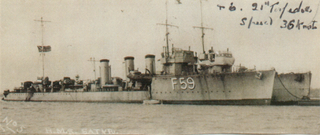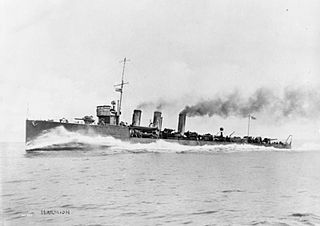
HMS Lance was a Laforey-class destroyer of the Royal Navy. Launched a few months before the outbreak of the First World War and attached to the Harwich Force, Lance took part in several engagements during the war, including the sinking of the Königin Luise and the Battle off Texel. She was responsible for firing the first British shot of the war.
HMS Starfish was an R-class destroyer which served with the Royal Navy. She was launched on 27 September 1916 and sold to be broken up on 21 April 1928. She was built by Hawthorn Leslie of Hebburn Tyne.
HMS Laverock was a Laforey-class destroyer of the Royal Navy. She was launched in 1913 and entered service in October 1914. Laverock served through the First World War, operating with the Harwich Force and in the English Channel. She was sold for scrap in 1921.

HMS Torrent was a Royal Navy R-class destroyer constructed and then operational in the First World War. She was sunk, with most of her crew in 1917. On 23 December 1917 Surprise, HMS Torrent, and Tornado sank after entering an Imperial German minefield.

HMS Tornado was a Royal Navy R-class destroyer constructed and then operational in the First World War. She was sunk, with most of her crew in 1917. On 23 December 1917 HMS Surprise, HMS Torrent, and HMS Tornado sank after entering an Imperial German minefield.

HMS Partridge was a Royal Navy Admiralty M-class destroyer constructed and then operational in the First World War, later being sunk by enemy action in 1917. The destroyer was the sixth Royal Navy vessel to carry the name HMS Partridge.

HMS Nimrod was a Marksman-class flotilla leader of the British Royal Navy. She was built by the Scottish shipbuilder Denny, with construction starting in 1914 and completed in August 1915. She served through the remainder of the First World War. She was sold for scrap in 1921.
HMS Lightfoot was a Marksman-class flotilla leader of the British Royal Navy. Construction by J. Samuel White began in June 1914, shortly before the outbreak of the First World War, and the ship was launched and completed in 1915. She survived the war and was sold for scrap in 1921.

HMS Rob Roy was a Royal Navy R-class destroyer constructed and then operational in the First World War. The ship served in the Grand Fleet as part of the Fifteenth Destroyer Flotilla.
HMS Recruit was an R-class destroyer built for the Royal Navy during the First World War. She was sunk by a German U-boat four months after she was commissioned in April 1917.

HMS Satyr was an R-class destroyer which served with the Royal Navy during the First World War. Launched on 27 December 1916, Satyr joined the Harwich Force under the command of Commander Hubert de Burgh. In 1917, the destroyer formed part of a force protecting the monitors Erebus and Terror in their bombardment of Ostend. As part of this action, Satyr, along with sister ships Taurus, Sharpshooter and Torrent, sank the German destroyer S20. After the war, the ship served with the Torpedo School at the Devonport. In 1923, the Navy decided to retire many of the older destroyers in preparation for the introduction of newer and larger vessels and Satyr was sold to be broken up on 16 December 1926.

HMS Sharpshooter was an R-class destroyer which served with the Royal Navy during World War I. Launched on 27 February 1917, the ship joined the Harwich Force, undertaking convoy escort duties. The vessel also took part in the Navy’s bombardment of Ostend later that year. On 1 June 1918, the destroyer rescued Captain A. C. Sharwood, one of the first pilots of the Royal Australian Navy, who ditched his Sopwith 2F.1 Camel nearby. After the war, Sharpshooter joined the Navy gunnery training establishment at Plymouth, but did not stay long and was reduced to Reduced Complement on 5 March 1919. The Royal Navy was rationalising its destroyer force and Sharpshooter, deemed superfluous, was sold to be broken up on 29 April 1927.

HMS Simoom was an R-class destroyer which served with the Royal Navy during World War I. Launched on 30 October 1916, the vessel operated as part of the Harwich Force until torpedoed by the German destroyer S50 on 23 January 1917. The ship's magazine exploded and 47 people died. The name was reused by the first S-class destroyer, Simoom, launched on 26 January 1918.
HMS Milne was a Royal Navy Admiralty M-class destroyer. Milne was built by John Brown & Company from 1913 to 1914 and was completed in December that year. She served through the remainder of the First World War, at first with the Harwich Force with which she took part in the Battle of Dogger Bank in January 1915, and later with the Dover Patrol, sinking the German submarine UC-26 in May 1917. Milne was sold for scrap in 1921.

HMS Linnet was a Laforey-class destroyer that served with the Royal Navy during the First World War. Launched on 16 August 1913 as HMS Havock, the ship was renamed on 30 September under an Admiralty order to become one of the first destroyers in a class named alphabetically. This convention subsequently became the norm. On commissioning, the vessel joined the Third Destroyer Flotilla and operated as part of the Harwich Force. The destroyer was first commanded by Commander Loftus Jones who named his daughter Linnette after the ship. During the War, the destroyer took part in the Battle of Heligoland Bight in 1914, and escorted minelayers on missions to lay mines. It was during one the latter missions that the ship was nearly hit by a gun hurled from the stricken minelayer Amphion. With the cessation of hostilities, the ship was placed in reserve and sold to be broken up on 4 November 1921.

HMS Setter was an R-class destroyer which served with the Royal Navy during the First World War. The R class were an improvement on the previous M class with geared steam turbines to improve efficiency. Laid down by J. Samuel White at East Cowes on the Isle of Wight, the destroyer was launched on 18 August 1916 and joined the Harwich Force. The ship escorted merchant vessels that travelled between the United Kingdom and the Netherlands as part of a small flotilla of destroyers. The convoys were subject to attack from German warships, but Setter was never hit by enemy attack. Instead, during the foggy night of 17 May 1917, the destroyer was struck by sister ship Sylph, leader of the small flotilla. The damage was critical and the crew were evacuated to Sylph as Setter sank with no loss of life.

HMS Moorsom was an Admiralty M-class destroyer which served in the Royal Navy during the First World War. The M class was an improvement on the preceding L class, capable of higher speed. Moorsom, the first ship to enter navy service to be named after Admiral Sir Robert Moorsom, was launched in December 1914, initially serving as part of the Grand Fleet before being transferred to the Harwich Force the following year. Briefly rejoining the Grand Fleet, the destroyer saw service in the Battle of Jutland in 1916 supporting the British battlecruisers and received hits from a battleship of the German High Seas Fleet. Moorsom also undertook other duties, including escorting the troop ship Mauretania in June 1915 and the minelayer Princess Margaret in August 1915 and November 1916. Placed within the Dover Patrol, the destroyer formed part of the cover for monitors including Erebus and Terror on attacks on Ostend and Zeebrugge in May and June 1917, and April and May 1918. After the Armistice, the destroyer was placed in reserve and subsequently sold to be broken up in November 1921.

HMS Napier was a Repeat Admiralty M-class destroyer which served in the Royal Navy during the First World War. The M class were an improvement on the previous L-class destroyer, capable of higher speed. The vessel was launched on 27 November 1915 and joined the Grand Fleet. Napier had a varied war career, acting as part of the destroyer screen for the First Battle Squadron during the Second Battle of Heligoland Bight and searching for the survivors of losses like the armoured cruiser HMS Hampshire. The vessel was usually based at Scapa Flow but spent a brief time seconded to the Harwich Force in 1917. After the Armistice that marked the end of the First World War, Napier was placed in reserve before being decommissioned and sold to be broken up on 8 November 1921.

HMS Sylph was an R-class destroyer that served in the Royal Navy during the First World War. The R class were an improvement on the previous M class with geared steam turbines to improve efficiency. Launched by Harland & Wolff at Govan on 10 February 1917, Sylph joined the Harwich Force and escorted merchant ships and convoys in the North Sea. The ship encountered both German submarines and torpedo boats but did not record any hits on the enemy. However, during one action in foggy weather, the destroyer struck and sank sister ship Setter. After the Armistice that ended the war, the destroyer was initially placed in the reserve before being transferred to the Torpedo School in 1919. On 16 December 1926, Sylph was sold to be broken up.

HMS Stork was an R-class destroyer that served in the Royal Navy during the First World War. The R-class were an improvement on the previous M-class with geared steam turbines to improve efficiency. Launched by Hawthorn Leslie at Hebburn in 1917, Stork joined the Harwich Force. The destroyer saw service escorting convoys in the English Channel and encountered both German submarines and torpedo boats, but did not record any hits on the enemy. The vessel also supported attacks on German forces on the coast of Western Europe by Coastal Motor Boats, flying boats and monitors, including the Zeebrugge Raid of 1918.









